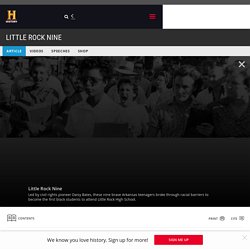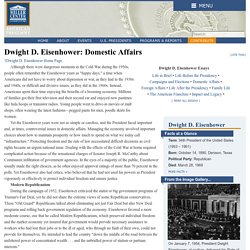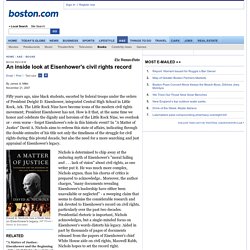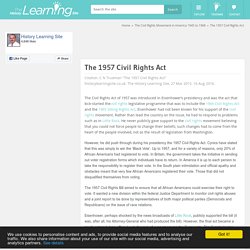

Part A. CONFUSED about Civil Rights? Watch this! Integration of Central High School - Black History. In the following weeks, federal judge Richard Davies began legal proceedings against Governor Faubus, and President Dwight D.

Eisenhower attempted to persuade Faubus to remove the National Guard and let the Little Rock Nine enter the school. Judge Davies ordered the Guard removed on September 20, and the Little Rock Police Department took over to maintain order. The police escorted the nine African-American students into the school on September 23, through an angry mob of some 1,000 white protesters gathered outside. Amidst ensuing rioting, the police removed the nine students. The following day, President Eisenhower sent in 1,200 members of the U.S. Numerous legal challenges to integration continued throughout the year, and Faubus repeatedly expressed his wish that the Little Rock Nine be removed from Central High.
Melba Patillo, for instance, was kicked, beaten and had acid thrown in her face. Brown VS Board Of Education Documentary. Little Rock- School Integration. Montgomery Bus Boycott. Montgomery Bus Boycott. Ike Liked Civil Rights. Dwight D. Eisenhower: Domestic Affairs—Miller Center. Although there were dangerous moments in the Cold War during the 1950s, people often remember the Eisenhower years as "happy days," a time when Americans did not have to worry about depression or war, as they had in the 1930s and 1940s, or difficult and divisive issues, as they did in the 1960s.

Instead, Americans spent their time enjoying the benefits of a booming economy. Millions of families got their first television and their second car and enjoyed new pastimes like hula hoops or transistor radios. Young people went to drive-in movies or malt shops, often wearing the latest fashions—pegged pants for men, poodle skirts for women. Yet the Eisenhower years were not so simple or carefree, and the President faced important and, at times, controversial issues in domestic affairs. Managing the economy involved important choices about how to maintain prosperity or how much to spend on what we today call "infrastructure. " Modern Republicanism Prosperity and Poverty Eisenhower and McCarthy. Eisenhower as an unsung hero of civil rights. Fifty years ago, nine black students, escorted by federal troops under the orders of President Dwight D.

Eisenhower, integrated Central High School in Little Rock, Ark. The Little Rock Nine have become icons of the modern civil rights movement; President Eisenhower has not. How is it that, at the same time we honor and celebrate the dignity and heroism of the Little Rock Nine, we overlook or - even worse - forget Eisenhower's role in this historic event? In "A Matter of Justice" David A. Nichols aims to redress this state of affairs, indicating through the double entendre of his title not only the timeliness of the struggle for civil rights during this pivotal decade, but also the need for a more searching and just appraisal of Eisenhower's legacy. Nichols is determined to chip away at the enduring myth of Eisenhower's "moral failing and . . . lack of vision" about civil rights, as one writer put it. James A. . © Copyright 2007 Globe Newspaper Company. The 1957 Civil Rights Act. The Civil Rights Act of 1957 was introduced in Eisenhower’s presidency and was the act that kick-started thecivil rights legislative programme that was to include the 1964 Civil Rights Act and the 1965 Voting Rights Act.

Eisenhower had not been known for his support of the civil rights movement. Rather than lead the country on the issue, he had to respond to problems such as in Little Rock. He never publicly gave support to the civil rights movement believing that you could not force people to change their beliefs; such changes had to come from the heart of the people involved, not as the result of legislation from Washington. The 1960 Civil Rights Act. The 1960 Civil Rights Act was born towards the end of 1958.

Following the 1957 Civil Rights Act, Eisenhower introduced another civil rights bill in late 1958, which was his reaction to a violent outbreak of bombings against churches and schools in the South. Though Eisenhower is not automatically linked to thecivil rights issue, his contribution, including the 1957 Act, is important as it pushed the whole civil rights issue into the White House. Once again, politicians from the South were furious over what they saw as Federal interference in state affairs. The bill became an act in 1960 as both parties were fighting for the ‘Black Vote’. The 1960 Civil Rights Act introduced penalties to be levied against anybody who obstructed someone’s attempt to register to vote or someone’s attempt to actually vote. SAT Subject Test: U.S. History: Civil Rights Under Truman and Eisenhower.